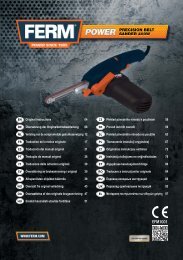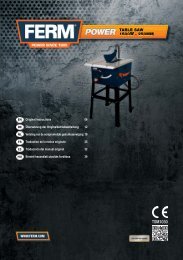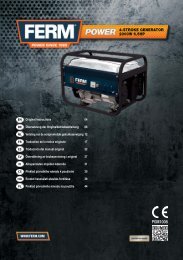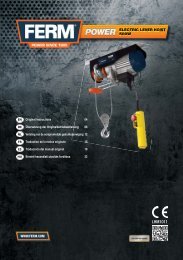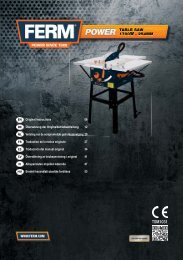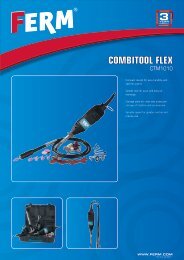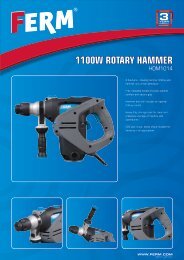You also want an ePaper? Increase the reach of your titles
YUMPU automatically turns print PDFs into web optimized ePapers that Google loves.
following wiring instructions are followed.<br />
The wires in the mains cable are coloured in<br />
accordance with the following code:<br />
blue neutral<br />
brown live<br />
As the colours of the wires in the mains cable of<br />
the unit may not correspond to the coloured<br />
markings identifying the terminals in the plug,<br />
proceed as follows:<br />
- The wire which is coloured blue must be<br />
connected to the terminal which is marked with<br />
the letter N or coloured black.<br />
- The wire which is coloured brown must be<br />
connected to the terminal which is marked with<br />
the letter L or coloured red.<br />
TECHNICAL DATA<br />
<strong>AGM1029</strong><br />
Mains voltage V~ 220-240<br />
Mains frequency Hz 50<br />
Power input W 2,000<br />
No-load speed min -1 6,000<br />
Grinding disc<br />
Diameter mm 230<br />
Bore mm 22<br />
Spindle thread M14<br />
Weight kg 5.7<br />
NOISE AND VIBRATION<br />
<strong>AGM1029</strong><br />
Sound pressure (L pa ) dB(A) 94.5<br />
Acoustic power (L wa ) dB(A) 107.5<br />
Uncertainty (K) dB(A) 3<br />
Vibration m/s 2 6.63<br />
Uncertainty (K) m/s 2 1.5<br />
Vibration level<br />
The vibration emission level stated in this<br />
instruction manual has been measured in<br />
accordance with a standardised test given in EN<br />
60745; it may be used to <strong>com</strong>pare one tool with<br />
another and as a preliminary assessment of<br />
exposure to vibration when using the tool for the<br />
applications mentioned<br />
- using the tool for different applications, or with<br />
different or poorly maintainted accessories, may<br />
significantly increase the exposure level<br />
- the times when the tool is switched off or when it<br />
is running but not actually doing the job, may<br />
signifi cantly reduce the exposure level<br />
Protect yourself against the effects of vibration by<br />
maintaining the tool and its accessories, keeping<br />
your hands warm, and organizing your work<br />
patterns<br />
2<br />
Wear hearing protection.<br />
DESCRIPTION (fIg. A)<br />
Your angle grinder has been designed for grinding<br />
and cutting masonry and steel.<br />
1. On/off switch<br />
2. Lock-off button<br />
3. Spindle lock button<br />
4. Spindle<br />
5. Guard<br />
6. Main grip<br />
7. Auxiliary grip<br />
8. Release button for main grip<br />
9. Carbon brush holder<br />
ASSEMBLy<br />
4<br />
Before assembly, always switch off the<br />
machine and remove the mains plug<br />
from the mains.<br />
Mounting and removing the guard (fig. B)<br />
2<br />
Do not use the machine without the<br />
guard.<br />
Mounting<br />
● Place the machine on a table with the spindle<br />
(4) facing upwards.<br />
● Keep the spindle lock button (3) pressed and<br />
remove the flange (10) using the flange key (11).<br />
● If necessary, remove the grinding disc (12).<br />
● Remove the flange (13).<br />
● Mount the guard (5). Secure the guard (5) by<br />
tightening the Allen screw (14) and the nut (15)<br />
with the Allen key (16).<br />
● Mount the flange (13).<br />
● If necessary, mount the grinding disc (12).<br />
● Keep the spindle lock button (3) pressed and<br />
mount the flange (10) using the flange key (11).<br />
Removing<br />
● Place the machine on a table with the spindle<br />
(4) facing upwards.<br />
● Keep the spindle lock button (3) pressed and<br />
remove the flange (10) using the flange key (11).<br />
● If necessary, remove the grinding disc (12).<br />
7<br />
EN








